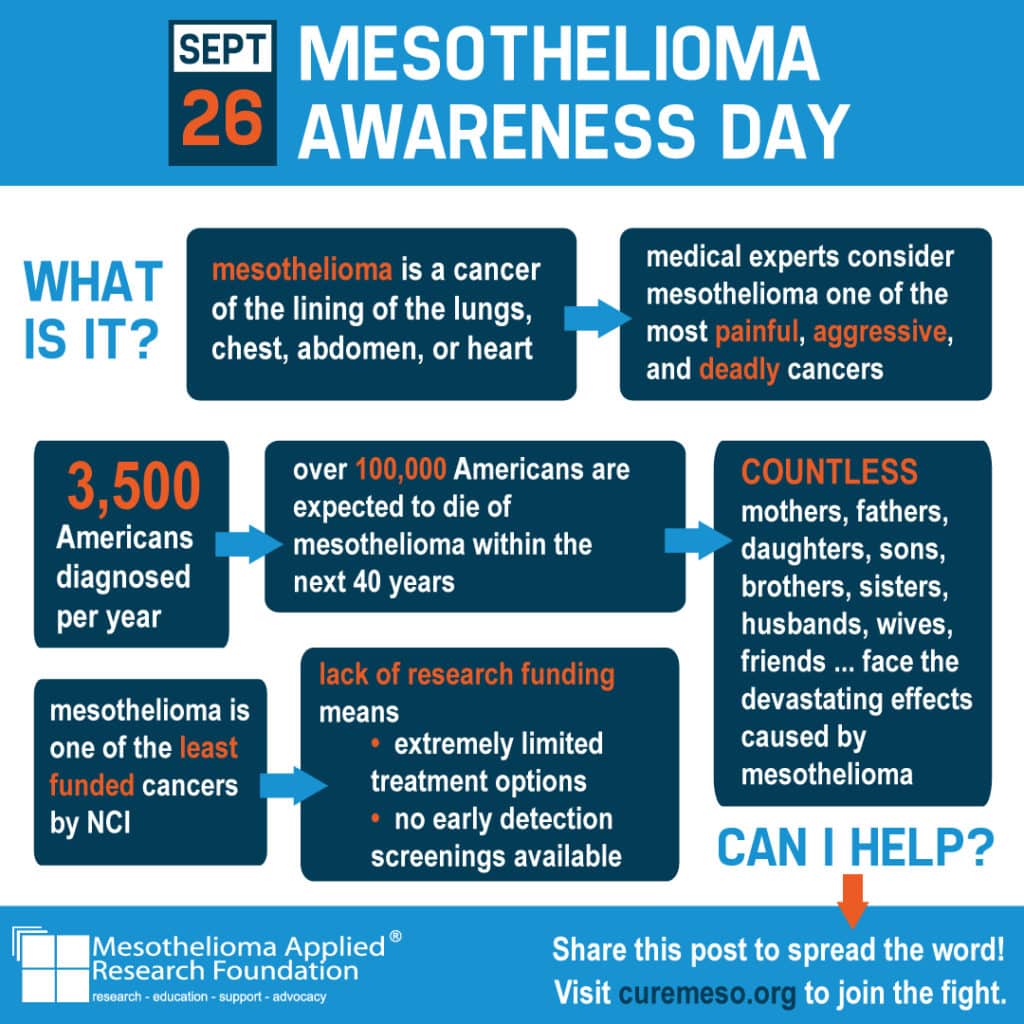Category: Featured News

Thanksgiving is Different This Year for Mesothelioma Patients
Each year at this time we celebrate Thanksgiving. Since the Pilgrims started this tradition it is a time to share and be grateful for our blessings. As Thanksgiving 2021 rapidly approaches, we reflect on what this year’s holiday means to ourselves and our loved ones and to our collective community.
As we all know, what makes this year different from last year and previous celebrations of Thanksgiving is the Covid-19 pandemic. Last year, 2020, was pre-vaccination. A lot of people had small celebrations and stayed home. This year with vaccinations available we take a step closer to what normal used to be.
Thanksgiving traditionally involves family gatherings, turkey dinners, and for some travel to relatives for the celebrations. The gatherings are times that families and friends can reconnect. Although not all Thanksgiving celebrations and memories are as picture perfect as we would like, they are all our own unique families with our different opinions gathering and interacting.
According to a recent survey from Ohio State University Wexner Medical Center, the mood that most U.S adults described toward Thanksgiving 2021 was “cautious.”
There are some indicators that Thanksgiving celebrations are getting back to normal. According to recent reports, travel is returning to pre-Pandemic levels. The same poll says that 63% of Americans will celebrate Thanksgiving with the same number of people as they did before the coronavirus pandemic, with 5% saying there will be more people attending their Thanksgiving this year compared to pre-pandemic times. Once people get to their destinations they may find that the hosts for their celebrations are asking about their vaccination status. Another recent survey tells us that half of all Americans plan to inquire about their potential guests’ vaccination status. Covid 19 negative tests will be required by 46% from unvaccinated friends and families.
As we all adjust to the “new normal,” for our Thanksgiving celebrations we celebrate and give thanks for progress that continues to be made in fighting malignant mesothelioma. All of us can take the lessons of the past year and a half and turn them into something positive. Appreciate each other and our relationships. Be thankful!
No matter how you choose to celebrate, stay safe and Happy Thanksgiving!

For Mesothelioma Patients, Time is What You Make of It
Time is one of our greatest assets. According to Miriam Webster the meaning is “the thing that is measured as seconds, minutes, hours , days, years, etc.” Time is something we all have, we just don’t know how much.
Many illnesses threaten our timeline and sometimes force us to look at how we spend our time. Malignant mesothelioma is bad news, with some options, but still with no cure. Researchers, doctors and scientists continue to push science for more information. When diagnosed with this disease or any other serious illness, looking for a timeline is natural. The question often asked is “how much time do I have?” Although no one can say with certainty, there are averages of time that are based on previous patients. When faced with the knowledge that you have a serious illness and your time may be limited, most want the best of what time is left. The best for one, can be different for the next.
I met a woman a few months ago, she had undergone a pleural biopsy. She was pretty convinced that she had pleural malignant mesothelioma. Prior to confirmation she told me she would choose wisely what type of treatment she would opt in for – which was ultimately immunotherapy. She has responded positively but has been left with some side effects. Her goal is to move out of her present housing situation and live somewhere easier. Physically, emotionally, and financially she has had to make some tough decisions. She feels as if these changes will give her a better quality of whatever time she has. Fortunately, she has a support system and a plan.
Dealing with terminal illness forces us to ask ourselves, how will we live out our remaining days? Some, if allowed, “live like they are dying.” Receiving a terminal illness as a diagnosis almost always forces one to reflect upon their life, and where and what they would like to do with whatever time remains.
We all measure time with different clocks. Some mark time by births, weddings, deaths, current events. However you choose to measure time, don’t forget to live it and enjoy it. We know when one is diagnosed with a terminal illness it feels as if time is standing still. Despite whatever time you have left, you are given the opportunity to have many conversations with people . These illnesses allow one to say “I love you”, make amends or share some intimate conversations.
All of us need to cherish our time and relationships for time is promised to no one.

18th Annual Mesothelioma Awareness Day
Today is the 18th Annual Mesothelioma Awareness Day. This day is set aside to raise awareness of malignant mesothelioma and the need for research.
Malignant mesothelioma is a rare disease that affects around 3,000 people a year in the United States. A disease is considered rare if it affects less than 200,000 Americans a year.
The leading cause of malignant mesothelioma is exposure to asbestos. The exposure can happen as far as 50 years in the past. A lot of Americans assume that this is a disease that does not happen anymore because they think asbestos is banned. Neither of these premises are true.
Through awareness and research progress has been made. Research has given patients options that were not in play in the past. We have seen the direct role that research has played in moving the survivability of patients with mesothelioma from months to living with mesothelioma as a chronic disease.
The mesothelioma community is an active community. Organizing a group to successfully spread awareness is a challenge.
The main group behind the Mesothelioma Awareness Day is the Mesothelioma Applied Research Foundation. They raise awareness and fund research that hopefully will lead to a cure. The Foundation was instrumental in starting and growing this annual day.
Some of the ways that we can all spread the word about malignant mesothelioma is to wear blue on Sunday, support local efforts like walks, and support social media efforts to share the message. Individually we can talk with people about the disease and the devastation that it inflicts on families and help spread facts of this disease.
With the pandemic we have seen what awareness and sense of urgency can do. Making scientific research a focus and a national priority can help further the search for a cure. Research and support of research is the key to curing mesothelioma.
On Sunday, September 26, 2021 spend some time spreading the word!

Like America, Transitions in Care are Critical for Mesothelioma Patients
As the United States awaits the peaceful transfer of power from one administration to another, transitions are at the forefront of the news. We are all being reminded of what an important role that transitions play in life. Whether the transitions be personal or public, transitions are times of change. Transitions involve communication and education, they can be physical or emotional.
The importance of transitions in dealing with the medical system cannot be understated. Transitions of care have been studied extensively in the health care system and identified as an area that needs improvement.
Different factors that can influence a successful transition of care are communication breakdown, patient education breakdown, and an accountability breakdown.
Being diagnosed with a serious illness or cancer like malignant mesothelioma can change the person’s life immediately.
A pleural mesothelioma patient that we recently visited was describing her journey with the disease. Her first symptom was a dry cough. The cough did not go away. Her family members urged her to go to her PCP and get the cough investigated. She did and was diagnosed with malignant mesothelioma within a few months. She was eligible for and had surgery.
Her journey has been full of transitions. As she spoke of her journey and what she had been through, one of the most challenging things for her was thinking of herself as being a patient with a serious cancer. She is an active person, had been on no medications, and the last thing she thought that her dry cough was from was a serious cancer.
As our patient continues on her journey with mesothelioma, her ability to deal with the disease and the change in the flow of her life are ongoing. As she adjusts to living with cancer and looks forward, one thing is certain: her life and her family’s lives have been changed.
We hope as she transitions to her “new normal” – as we hope for our country – and continues to be supported in her physical and emotional journey.

November is National Family Caregivers Month
October was Health Literacy Month and November is National Family Caregivers Month. Both of these special months highlight the importance of education, support, and understanding when dealing with or caring for a loved one. When faced with a diagnosis of malignant mesothelioma, understanding of the disease and what to look for helps both the patient and the caregiver.
The definition of health literacy from the Affordable Care Act of 2010 is “the degree to which an individual has the capacity to obtain, communicate, process, and understand basic health information and services to make health decisions.”
There is nothing simple about understanding the disease of malignant mesothelioma. From diagnosis through treatment the terminology and descriptions of the disease are difficult to understand and to even pronounce. The process of being diagnosed is usually after weeks or months of tests and scans, and after other common illnesses are ruled out. Health literacy can become an issue immediately.
A “family caregiver” is considered anyone who does not get paid but helps another person do what they can no longer do without assistance. Family caregivers provide extensive assistance which can include medications, shopping, preparing meals, cleaning, advocating, coordinating, educating – the list is very long, and the contributions vital.
For a rare serious disease like malignant mesothelioma, it is important for patients and families to understand what they are dealing with. The options for treatment can be confusing and the plan can change with further testing. The importance of being able to understand and trust your team is vital. Family caregivers are the link between the patient and their medical team. Having someone with you during this journey can be life saving. In order to give the patient the best possible chance for recovery and quality time, the family caregiver’s contribution and understanding of the disease and the patient is very important and often both overlooked and under appreciated.
Looking around, the number of people who in addition to maintaining their jobs and lives also provide care for someone else is staggering. The term “invisible army” has been given to these caregivers who often are not recognized.
We honor and thank all the family caregivers for their huge contribution to ongoing care for another person, family or not!
Free Mesothelioma Patient & Treatment Guide
We’d like to offer you our in-depth guide, “A Patient’s Guide to Mesothelioma,” absolutely free of charge.
It contains a wealth of information and resources to help you better understand the condition, choose (and afford) appropriate treatment, and exercise your legal right to compensation.
Download Now